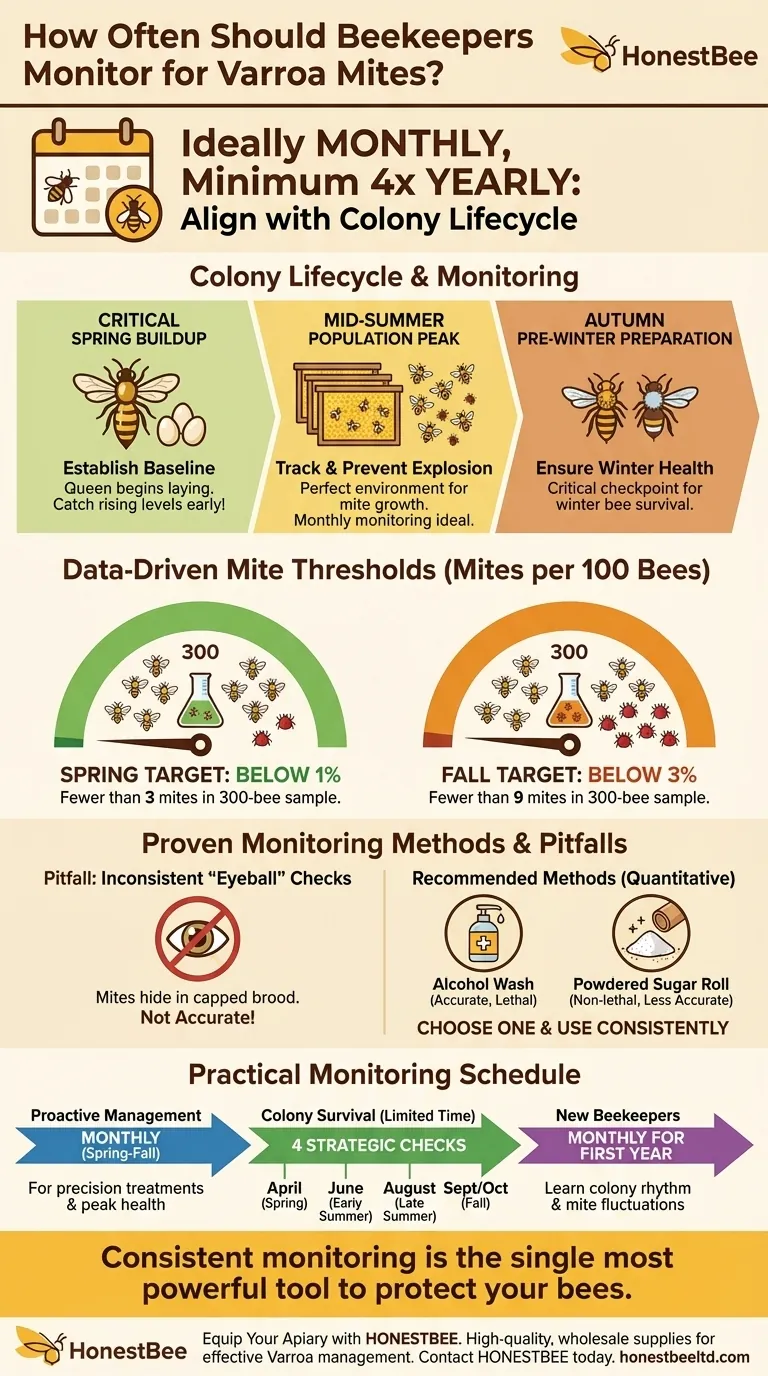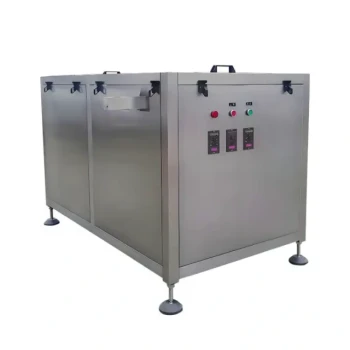To effectively manage Varroa mites, a beekeeper should monitor mite levels ideally once per month during the active season. If a monthly schedule is not feasible, a minimum of four critical checks per year is essential, timed to align with the colony's natural population cycle. This proactive approach is fundamental to preventing colony losses.
The core principle is not simply to count mites, but to gather data that allows you to intervene before mite populations reach a critical threshold. Regular monitoring is the difference between managing a problem and reacting to a disaster.

Why Monitoring Frequency is Tied to the Colony's Lifecycle
Varroa mite populations do not grow at a steady rate; their growth is directly linked to the amount of brood in your colony. Understanding this relationship is key to timing your monitoring efforts for maximum impact.
The Critical Spring Buildup
As the queen begins laying in late winter and early spring, the bee population starts to grow. The mite population also begins its growth cycle, laying its eggs within the capped brood cells.
An early spring check is your first opportunity to establish a baseline. Catching a rising mite level at this stage is crucial, as it's far easier to manage a small problem before it explodes.
The Mid-Summer Population Peak
By mid-summer, the bee and brood populations are at their peak. This creates the perfect environment for a Varroa mite population explosion.
A mite problem that seemed minor in the spring can become a full-blown infestation during this period. This is why monthly monitoring through the summer is the ideal, as it allows you to track the rate of increase and act decisively.
The Autumn Pre-Winter Preparation
This is arguably the most critical monitoring checkpoint of the year. In the fall, the colony is raising the "winter bees"—the specialized, long-living bees that will sustain the colony until spring.
If these winter bees are weakened by mites and the viruses they transmit, the colony has a very low chance of survival. A fall mite check tells you if your bees are heading into winter healthy and strong.
Understanding Mite Thresholds: Your Target Numbers
Monitoring is useless without knowing what the numbers mean. These data-driven thresholds, determined by extensive research, are your guide for when to take action.
The Spring Threshold: Below 1% Infestation
In the spring, your goal is to keep mite levels below 1 mite per 100 bees. This is equivalent to seeing fewer than 3 mites in a standard 300-bee alcohol wash or sugar roll sample.
Maintaining this low level is vital because both the bee and mite populations are in a growth phase. A low starting number gives the colony a significant advantage.
The Fall Threshold: Below 3% Infestation
In the fall, the recommended threshold is to keep mite levels below 3 mites per 100 bees (fewer than 9 mites in a 300-bee sample).
While slightly higher than the spring threshold, this level is still critical for ensuring the health of the winter bee population. Failing to get mite loads down before winter is one of the most common causes of colony death.
Common Pitfalls and Monitoring Methods
Effective management requires consistent and accurate data collection. Avoiding common pitfalls is as important as conducting the tests themselves.
Pitfall: Inconsistent or "Eyeball" Monitoring
Simply looking for mites on the backs of bees during a hive inspection is not an accurate way to assess the true level of infestation. The vast majority of mites are hidden within capped brood cells.
To get reliable data, you must use a quantitative method. The most common methods are the alcohol wash and the powdered sugar roll, both of which provide a "mites per 100 bees" count.
Choosing Your Method
The alcohol wash is considered the most accurate method, but it is lethal to the sample of bees. The powdered sugar roll is non-lethal but can be slightly less accurate if not performed carefully.
The key is not which method you choose, but that you choose one method and use it consistently. This consistency allows you to compare your data accurately over time and see the real trends in your apiary.
A Practical Monitoring Schedule for Your Apiary
Your monitoring strategy should adapt to your specific goals and available time, but it must be consistent to be effective.
- If your primary focus is proactive management and hive productivity: Commit to monthly monitoring from spring through fall to enable precision treatments and maintain peak colony health.
- If your primary focus is colony survival with limited time: Perform a minimum of four strategic checks: one in early spring (April), one in early summer (June), one in late summer (August), and a final, critical pre-winter check in the fall (September/October).
- If you are new to beekeeping: Start with a monthly schedule for your first full year. This is the fastest way to learn your colony's rhythm and understand how mite levels fluctuate in your specific environment.
Consistent monitoring is the single most powerful tool you have to protect your bees and ensure their long-term survival.
Summary Table:
| Monitoring Period | Key Goal | Recommended Threshold (Mites per 100 Bees) |
|---|---|---|
| Spring Buildup | Establish baseline, prevent early growth | Below 1% (< 3 mites in 300-bee sample) |
| Mid-Summer Peak | Track and prevent population explosion | Monitor monthly; act if nearing 3% |
| Autumn Pre-Winter | Ensure health of winter bees | Below 3% (< 9 mites in 300-bee sample) |
Protect Your Apiary with the Right Equipment
Consistent monitoring is essential, but it requires reliable tools. HONESTBEE supplies commercial apiaries and beekeeping equipment distributors with the high-quality, wholesale-focused supplies needed for effective Varroa mite management—from durable testing kits to protective gear.
Contact HONESTBEE today to equip your operation for success and ensure the long-term health of your colonies.
Visual Guide

Related Products
- Adjustable Formic and Acetic Acid Dispenser for Bee Mite Treatment
- Professional Long-Handled Silicone Honey Scraper for Beekeeping
- Professional Dual-End Stainless Steel Hive Tool for Beekeeping
- Professional 3-Bar Frame Grip with Integrated Hive Tool
- HONESTBEE Advanced Ergonomic Stainless Steel Hive Tool for Beekeeping
People Also Ask
- How do Varroa mites spread between honey bee colonies? Stop Mite Transmission in Your Apiary
- What does Chewed Down Brood (CDB) indicate in bee colonies? A Sign of Varroa Mite Infestation
- What are the symptoms of Varroa Mite Syndrome (VMS)? Recognizing the Signs of Colony Collapse
- What should be done after treating a colony for varroa mites? A Step-by-Step Guide to Verifying Success
- What is the optimal time for varroa mite control in nucs? Maximize Efficacy with Perfect Timing



















